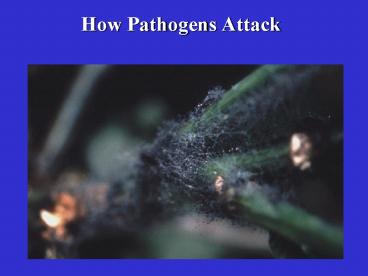How Pathogens Attack - PowerPoint PPT Presentation
1 / 18
Title:
How Pathogens Attack
Description:
Hemibiotrophs Sequence of Pathogenesis Events Dissemination/ contact ... Invasion Chemical Attack Pathogens may use chemicals to overcome plant defenses ... – PowerPoint PPT presentation
Number of Views:939
Avg rating:3.0/5.0
Title: How Pathogens Attack
1
How Pathogens Attack
2
Reading Assignment Chapter 26
3
Pathogen Attack Concepts
- Successful pathogens enter the host, overcome
plant defenses and cause disease - Pathogens use strategies such as mechanical
pressure, enzymes, toxins and hormones to attack
plants and overcome plant resistant mechanisms.
4
Selection Pressure
- Competition for nutrients is a source of
selection pressure that promotes parasitism on
plants - Microorganisms have evolved as saprophytes,
facultative saprophytes, facultative parasites,
endophytes, necrotrophs, and biotrophs.
Antibiosis
5
Endophytes
- Endophyte - microorganism living inside another
one. The association runs from antagonism to
mutualism. - Neotyphodium (Acremonium) species provide
mutualistic benefits to their grass hosts
produce alkaloids and phenolic toxins that deter
insects, nematodes and some fungal pathogens.
6
Hemibiotrophs
Hemibiotrophs are microorganisms that have
developed with plants where early in their life
cycle they have a dependence on living cells but
later can survive as facultative parasites or
facultative saprophytes.
7
Sequence of Pathogenesis Events
- Dissemination/ contact
- Penetration
- Establishment of food relationship within host
- Invasion
8
How Pathogens Attack
9
Dissemination/ Contact
- Propagules of pathogen must come in contact with
host (efficient method of dissemination or
produce high number of propagules. - Propagules must adhere to cell surface.
The fungus Penicillium produces millions of
conidia on a single orange.
10
Penetration
- When spores of fungi germinate, the tip of the
germ tube may swell and from a specialized
structure known as an appressorium. - An appressorium adheres to the cell surface and
has much higher turgor pressure than found within
normal hyphae.
11
Penetration
- From the appressorium, a penetration peg (pp)
much narrower than regular hyphae and
penetrates the cell walls. - Once the cell wall is breached, hyphae from the
tip of the pp resume their normal size. - Penetration of the cell wall by the pp is aided
by mechanical and biochemical mechanisms.
12
Establishment of food relationship within host
- Haustorium a specialized feeding cell that
invaginates (does not rupture the cell membrane). - Digestive enzymes pass out of the haustorium,
across the cell membrane and into the cytoplasm
of the cell - Food passes across the cell membrane from the
cell to the haustorium.
Intracelluar hyphae of a downy mildew fungus
with haustoria
13
Invasion
Xylella bacteria colonizing xylem vessels.
Soft rot of potato
14
Chemical Attack
- Pathogens may use chemicals to overcome plant
defenses to successfully penetrate, establish a
food relationship and invade the host. - These chemicals include enzymes, hormones,
toxins, and extracellular polysaccharides.
15
Enyzmes- used to attack host cells
- Pathogens may mobilize numerous enzymes to attack
walls of cells (primary and secondary) or the
middle lamella. - These enzymes include cutinases, pectinases,
cellulases, hemicellulases, ligninases,
proteases, lipases, and amylases.
16
Hormones
- Some genes involved with defense responses in
plants are downregulated by hormones and
susceptibility to some pathogens. - Hypersensitive response can also be inhibited by
hormones.
17
Toxins
- Phytotoxins are almost always secondary
metabolites. - Selective toxins have a specific activity, have
low molecular weights and are agents for
virulence or pathogenicity.
18
Toxins
- Sclerotium rolfsii produces a nonspecific
phytotoxin, oxallic acid, that is kills cells
prior to invasion by the fungus. - S. rolfsii is a necrotroph.





![About Nuclear, biological, and chemical [NBC] Attack? PowerPoint PPT Presentation](https://s3.amazonaws.com/images.powershow.com/10003306.th0.jpg?_=20240224121)

























